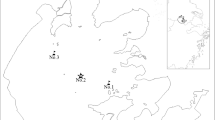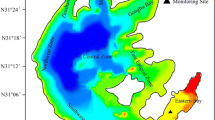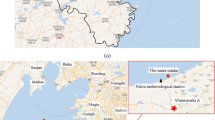Abstract
The disturbance of the water-sediment interface by wind-driven currents and waves plays a critical role in sediment resuspension and internal nutrient release in large, shallow lakes. This study analyzed the effects of the interactions between wind-induced currents an1d waves on the driving mechanism of sediment resuspension in Lake Taihu, the third largest freshwater lake in China, using acoustic and optic techniques to collect long-term, high-frequency, synchronous in situ measurements of wind, currents, waves, and suspended solid concentrations (SSCs). The results suggested that water turbidity started to increase at wind speeds of approximately 4 m/s and significantly increased when wind speeds exceeded 6 m/s. In most cases, wind-induced waves were the main energy source for changes in turbidity. Wave-generated shear stress contributed more than 95% to sediment resuspension and that only in weak wind conditions (<4 m/s) did the lake bottom shear stresses generated by currents and waves contributed equally. The relationship between SSC and bottom shear stress generated by wave was established by fitting the observed results. The processes of sediment dynamics were divided into four stages (A through D) according to three shear-stress thresholds. In stage A, SSC remained stable (about 45 mg/L) and τw was less than 0.02 N/m2. In stage B, the sediment bed was starting to be activated (SSC 45∼60 mg/L) and τw was in the range of 0.02∼0.07 N/m2. In stage C, a medium amount of sediment was suspended (SSC 60∼150 mg/L) and τw ranged from 0.07 to 0.3 N/m2. In stage D, large amount of sediment was suspended (SSC 150∼300 mg/L) and τw was larger than 0.3 N/m2. The findings of this paper reveal the driving mechanism of sediment resuspension, which may further help to evaluate internal nutrient release in large shallow Lake Taihu.








Similar content being viewed by others

References
Chung EG, Bombardelli FA, Schladow SG (2009) Sediment resuspension in a shallow lake. Water Resour Res 45(5):W05422
Fan C, Zhang L, Wang J, Zheng C, Gao G, Wang S (2004) Processes and mechanism of effects of sludge dredging on internal source release in lakes. Chinese Sci Bull 49(17):1853–1859
Fugate DC, Friedrichs CT (2002) Determining concentration and fall velocity of estuarine particle populations using ADV, OBS and LISST. Cont Shelf Res 22:1867–1886
Grant WD, Madsen OS (1979) Combined wave and current interaction with a rough bottom. J Geophys Res 84(C4):1797–1808
Green MO, Coco G (2014) Review of wave-driven sediment resuspension and transport in estuaries. Rev Geophys 52:77–117
Hawley N (2000) Sediment resuspension near the Keweenaw Peninsula, Lake Superior during the fall and winter 1990-1991. J Great Lakes Res 26(4):495–505
Hu K, Pang Y, Wang H, Wang X, Wu X, Bao K, Liu Q (2011) Simulation study on water quality based on sediment release flume experiment in Lake Taihu, China. Ecol Eng 37:607–615
James RT, Martin K, Wool T, Wang PF (1997) A sediment resuspension and water quality model of Lake Okeechobee. J Am Water Resour As 33(3):661–678
Ji ZG, Jin KR (2014) Impacts of wind waves on sediment transport in a large, shallow lake. Lakes Reserv Res Manage 19(2):118–129
Jiang W, Pohlmann T, Sundermann J, Feng S (2000) A modelling study of SPM transport in the Bohai Sea. J Marine Syst 24:175–200
Kumagai M (1988) Predictive model for resuspension and deposition of bottom sediment in a lake. Japanese J Limnol 49(3):185–200
Li GY, Sheng LX (2011) Model of water-sediment regulation in Yellow River and its effect. Sci China Technol Sci 54(4):924–930
Li YP, Pang Y, Chen KS, Peng JP, Ding L, Jin Y (2004) Study on the starting principles of sediment by water force in Taihu Lake. Adv Water Sci 15:770–774 (in Chinese)
Lick W (1994) The flocculation, deposition, and resuspension of fine-grained sediments. In “Transport and transformation of contaminants near the sediment-water interface”. Boca Raton, Fla., Lewis Publishers, 35–57
Lijklima L, Aalderink RH, Blom G, Van Duin EHS (1994) Sediment transport in shallow lakes-two case studies related to eutrophication. In: “Transport and transformation of contaminants near the sediment-water interface”. Boca Raton, Fla., Lewis Publishers, 253–279
Luo L (2004) Hydrodynamics and its effects on aquatic environment in Lake Taihu. Ph.D thesis, Nanjing Institute of Geography and Limnology, Chinese Academy of Sciences (in Chinese)
Luo L, Zhang F (2003) Application of ADP in the study of sediment resuspension in Lake Taihu. J Lake Sci 15(4):331–338 (in Chinese)
Luo L, Qin BQ, Hu WP, Zhang FB (2004) Wave characteristics in Lake Taihu. J Hydrodyn 19:664–670
Madsen OS (1976) In: Stainley JD, Swift DJP (eds) Wave climate of the continental margin: elements of its mathematical description, marine sediment transport and environmental management. Wiley, New York, pp. 65–90
Martin DP, Nittrouer CA, Ogston AS, Crockett JS (2008) Tidal and seasonal dynamics of a muddy inner shelf environment, Gulf of Papua. J Geophys Res (2003-2012) 113:F01507
Mehta AJ (1991) Characterization of cohesive soil bed surface erosion, with special refference to the relationship between erosion, shear strength and bed density. Report UFL/COEL/MP-91/4, Coastal and Oceanographic Engineering Department, University of Florida, Gainesville, 83p
Mian MH, Yanful EK (2004) Analysis of wind-driven resuspension of metal mine sludge in a tailings pond. J Environ Eng Sci 3:119–135
Nielsen P, Robert S, Møller-Christiansen B, Oliva P (2001) Infiltration effects on sediment mobility under waves. Coast Eng 42:105–114
Paerl HW, Huisman J (2008) Blooms like it hot. Science 320(5872):57
Qin B (Ed.) (2008) Lake Taihu, China: dynamics and environmental change (Vol. 87). Springer Science & Business Media
Qin B (2009) Lake eutrophication: control countermeasures and recycling exploitation. Ecol Eng 35:1569–1573
Qin B, Hu W, Chen W, Ji J, Fan C, Chen Y, Gao X, Yang L, Gao G, Huang W, Jiang J, Zhang S, Liu Y, Zhou Z (2000) Studies on the hydrodynamic processes and related factors in Meiliang Bay, Northern Taihu Lake, China. J Lake Sci 12:325–334 (in Chinese)
Qin B, Hu W, Gao G, Luo L, Zhang J (2004) Dynamics of sediment resuspension and the conceptual schema of nutrient release in the large shallow Lake Taihu, China. Chinese Sci Bull 49(1):54–64
Qin B, Zhu G, Zhang L, Luo L, Gao G, Gu B (2006) Estimation of internal nutrient release in large shallow Taihu Lake, China. Sci China Ser D 49:38–50
Qin B, Zhu G, Gao G, Zhang Y, Li W, Paerl HW, Carmichael WW (2010) A drinking water crisis in Lake Taihu, China: linkage to climatic variability and Lake management. Environ Manag 45:105–112
Reardon KE, Bombardelli FA, Moreno-Casas PA, Rueda FJ, Schladow SG (2014) Wind-driven nearshore sediment resuspension in a deep lake during winter. Water Resour Res 50(11):8826–8844
Rosales P, Ocampo-Torres FJ, Osuna P, Monbaliu J, Padilla-Hernández R (2008) Wave-current interaction in coastal waters: effects on the bottom-shear stress. J Marine Syst 71:131–148
Sheng YP, Lick W (1979) The transport and resuspension of sediments in a shallow lake. J Geophys Res 84(C4):1809–1826
Stone R (2011) China aims to turn tide against toxic lake pollution. Science 333:1210–1211
Wang A, Ye X, Du X, Zheng B (2014) Observations of cohesive sediment behaviors in the muddy area of the northern Taiwan Strait, China. Cont Shelf Res 90:60–69
Whitehouse R, Soulsby R, Roberts W, Mitchener H (2000) Dynamics of estuarine muds: a manual for practical applications. Thomas Telford (210 p)
Wu T, Qin B, Zhu G, Zhu M, Wei L, Luan C (2013) Modeling of turbidity dynamics caused by wind-induced waves and current in the Taihu Lake. Int J Sediment Res 28(2):139–148
Zamparas M, Zacharias I (2014) Restoration of eutrophic freshwater by managing internal nutrient loads. A review Sci Total Environ 496:551–562
Zhou JJ, Zhang M, Cao HQ (2011) Removing coarse sediment by sorting of reservoirs. Sci China Technol Sci 54(4):903–913
Zhu G, Qin B, Gao G (2005) Direct evidence of phosphorus outbreak release from sediment to overlying water in a large shallow lake caused by strong wind wave disturbance. Chinese Sci Bull 50:577–582
Zhu M, Zhu G, Zhao L, Yao X, Zhang Y, Gao G, Qin B (2013) Influence of algal bloom degradation on nutrient release at the sediment–water interface in Lake Taihu, China. Environ Sci Pollut Res 20(3):1803–1811
Acknowledgements
The research was supported by the Chinese National Science Foundation (51579071, 51379061, 41323001, 51539003), the Jiangsu Province National Science Foundation (BK20131370), and the National Science Funds for Creative Research Groups of China (No. 51421006), and the program of Dual Innovative Talents Plan and Innovative Research Team in Jiangsu Province, the Special Fund of State Key Laboratory of Hydrology-Water Resources and Hydraulic Engineering, and the Fundamental Research Funds for the Central Universities.
Author information
Authors and Affiliations
Corresponding authors
Additional information
Responsible editor: Philippe Garrigues
Rights and permissions
About this article
Cite this article
Li, Y., Tang, C., Wang, J. et al. Effect of wave-current interactions on sediment resuspension in large shallow Lake Taihu, China. Environ Sci Pollut Res 24, 4029–4039 (2017). https://doi.org/10.1007/s11356-016-8165-0
Received:
Accepted:
Published:
Issue Date:
DOI: https://doi.org/10.1007/s11356-016-8165-0



